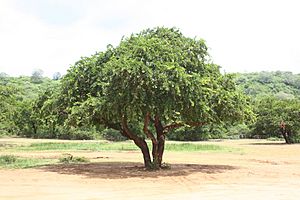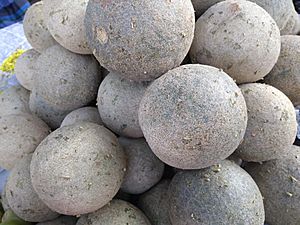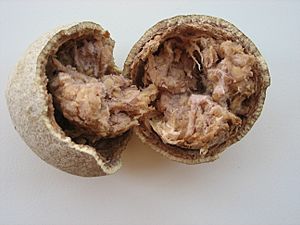Limonia acidissima facts for kids
Quick facts for kids Limonia acidissima |
|
|---|---|
 |
|
| In Trincomalee, Sri Lanka | |
| Scientific classification | |
| Genus: |
Limonia (plant)
|
| Species: |
acidissima
|
| Synonyms | |
|
Genus:
Species:
|
|
The wood-apple (scientific name: Limonia acidissima) is a unique tree. It's the only type of plant in its group, called the Limonia genus. People also call it the elephant-apple.
Description
The wood-apple tree is quite large. It can grow up to 9 metres (30 ft) (about 30 feet) tall. Its bark is rough and has spines.
The leaves of the wood-apple tree are special. They are pinnate, which means they have smaller leaflets arranged along a central stem, like a feather. Each leaf has 5 to 7 leaflets. These small leaves are about 25–35 mm long and 10–20 mm wide. If you crush them, they smell like citrus fruits.
The flowers of the wood-apple tree are white and have five petals. The fruit is a type of berry. It measures about 5–9 cm (2–3.5 inches) across. The taste can be either sweet or sour.
One of the most interesting things about the wood-apple fruit is its very hard shell. It can be tough to crack open! The outside of the fruit looks greenish-brown. Inside, you'll find sticky brown pulp and small white seeds. The fruit looks a bit like the Bael fruit.
Wood-apple fruit is packed with good things for your body. It has a lot of protein, carbohydrates, iron, fat, calcium, and vitamins B and C. About 100 grams of ripe fruit pulp contains around 49 calories.
Where Wood-Apples Grow
The wood-apple tree is originally from India (including the Andaman Islands), Bangladesh, and Sri Lanka. It has also been brought to other parts of Asia, like Indochina and Malesia.
Uses of the Wood-Apple
The fruit of the wood-apple tree is used in many ways. People make a special fruit juice from it. This juice has astringent properties, meaning it can help tighten tissues. Jams are also made from the fruit.
Ripe wood-apple fruit can be used to make a type of pickle. This is done by mashing it with green chili pepper, sugar, and salt.
In some Hindu traditions, this fruit is considered sacred. It is offered to the gods Shiva and Ganesha during religious ceremonies called pujas. Many Hindu temples have a sacred tree, known as the Sthala Vriksha, within their grounds.
In Myanmar, the wood from the tree is used to create thanaka. This is a yellowish-white paste that people apply to their faces. It's used as a cosmetic and also helps protect the skin from the sun.
Nutrition
| Nutritional value per 100 g (3.5 oz) | |
|---|---|
| Energy | 518.816 kJ (124.000 kcal) |
|
18.1 g
|
|
| Sugars | 0 g |
| Dietary fiber | 5 g |
|
3.7 g
|
|
|
Protein
|
7.1 g
|
| Vitamins | Quantity
%DV†
|
| Thiamine (B1) |
3%
0.04 mg |
| Riboflavin (B2) |
1417%
17 mg |
| Niacin (B3) |
50%
8 mg |
| Vitamin C |
4%
3 mg |
| Minerals | Quantity
%DV†
|
| Calcium |
13%
130 mg |
| Iron |
46%
6 mg |
| Manganese |
857%
18 mg |
| Zinc |
105%
10 mg |
| Other constituents | Quantity |
| Water | 64.2 g |
|
in Fruit Wood Apple values are for edible portion
|
|
| †Percentages estimated using US recommendations for adults. Source: 1 |
|
See also
 In Spanish: Limonia acidissima para niños
In Spanish: Limonia acidissima para niños




